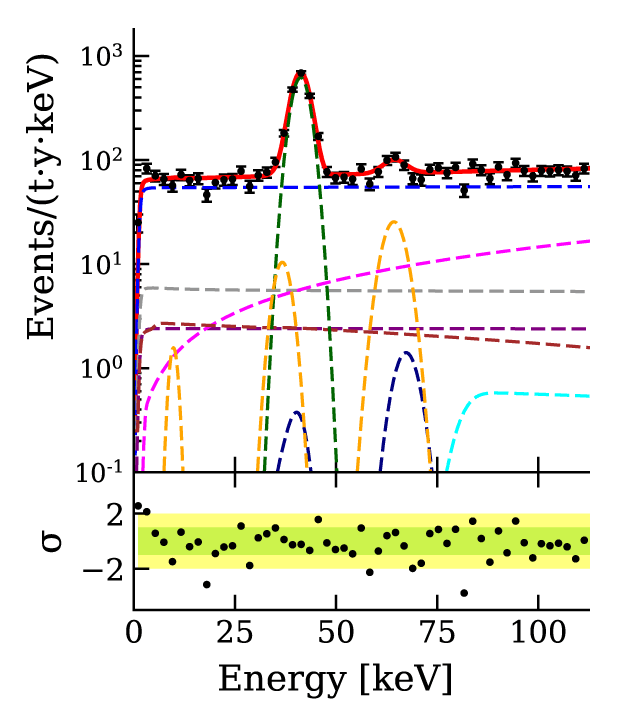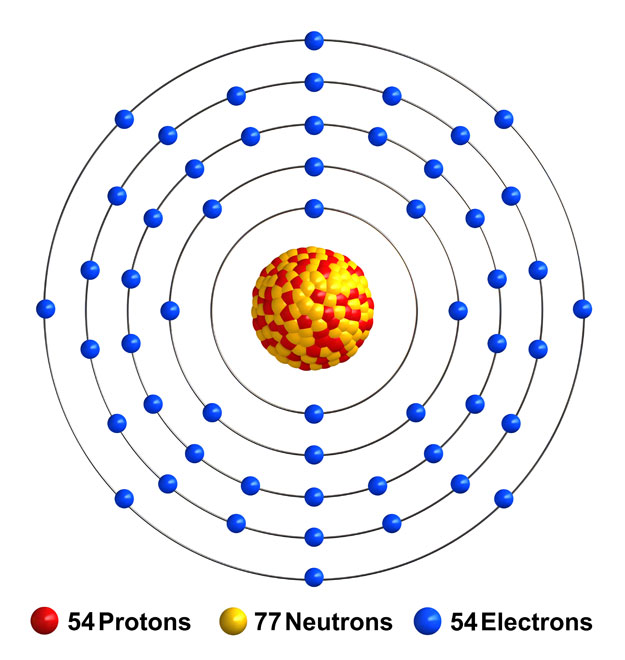
20th June 2020 Possible first detection of axion particle Physicists at the XENON dark matter research facility report an "excess" of 53 events, which may hint at the existence of hypothetical particles called solar axions.
The international XENON collaboration, installed deep underground at Gran Sasso laboratory in Italy, is the world's most sensitive dark matter experiment. Previous breakthroughs have included the rarest event ever recorded, when scientists at the facility observed the radioactive decay of xenon-124, which has a half-life of 1.8 X 10²² years (a trillion times longer than the age of the Universe). The XENON1T, an upgrade of the main detector, consists of a time projection chamber (TPC) measuring 1 metre x 1 metre. This contains 3.2 tons of ultra-pure liquid xenon, which in turn is housed in a 10 m water tank. The experiment aims to identify rare events produced when particles interact within the liquid xenon – a chemically inert "noble" element (pictured below). This week, a team at XENON1T announced their latest new discovery. Data from their experiment revealed a surprisingly high "excess" of electron recoils over the known backgrounds – the source of which is not yet fully understood.
Diagram of a xenon atom.
The ultra-pure liquid xenon serves as a "target" for particle interactions. When a particle crosses the target, it can generate tiny signals of light and free electrons from a xenon atom. Most of these interactions occur from particles that are known to exist. Scientists therefore carefully estimated the number of background events in XENON1T. Comparing data from XENON1T to known backgrounds, they noted 285 such events – an excess of 53 above the expected number of 232. This raises the exciting question: where is the excess coming from? Three explanations are being considered. The first, and most mundane, is tritium contamination in the detector. For this to be true, however, it would have to be 100 times more tritium than expected after purification. Two more exciting possibilities are that the signature is a particle known as the solar axion, or that it represents a previously unknown property of neutrinos. The axion, first theorised in 1977, is a hypothetical elementary particle that could be a principal component of dark matter – the invisible, unseen stuff that binds our Universe together and accounts for 85% of its material. Axions may resolve problems in the maths governing the strong force, which holds matter together and is one of the four known fundamental interactions (the others being electromagnetism, the weak force, and gravitation). If the axion signal is confirmed by the XENON collaboration, however, it would be a "solar" axion produced recently in the Sun – as opposed to a dark matter candidate having originated from and shaped the early Universe, the team explains. This new class of particle, nevertheless, would have a major impact on our understanding of fundamental physics and astrophysical phenomena. Alternatively, the excess could be due to neutrinos – trillions of which pass through your body, unhindered, every second. One explanation could be that the magnetic moment (a property of all particles) of neutrinos is larger than its value in the Standard Model of elementary particles. This would be a strong indication of new physics needed to explain it.
Of the three hypotheses considered by the scientists, a signal produced by the solar axion particle is the most favoured. In statistical terms, it has a significance of 3.5 sigma, meaning that there is about a 2/10,000 chance that the observed excess is due to a random fluctuation rather than a signal. While this significance is fairly high, it is not yet large enough to confirm that axions exist. A further upgrade to the facility, called the XENONnT, will provide additional capacity for data, with an active xenon mass three times larger and a lower background, when it starts later this year. Future studies could then determine whether this excess is a mere statistical fluke, a background contaminant, or something far more exciting: a new particle or interaction that goes beyond known physics. "Although the WIMP has been the dominant DM [dark matter] paradigm for many years, the axion has been around about as long, and recent years have seen a surge in experiments looking for axions," said Tien-Tien Yu, a physicist at the University of Oregon, who was not involved in the experiment. "If this turns out to be a new particle, then it's a breakthrough we have been waiting for for the last 40 years," said Adam Falkowski, a particle physicist at Paris-Saclay University in France, who was also not involved in the experiment. "You cannot overstate the importance of the discovery, if this is real." "If this bears out, and *if* is a big question, this is the biggest game changer in my corner of physics since the discovery of cosmic acceleration," said Chanda Prescod-Weinstein, a physicist at the University of New Hampshire who is not part of the collaboration. In the meantime, the XENON team have published the results of their latest study on arXiv.
Comments »
If you enjoyed this article, please consider sharing it:
|









